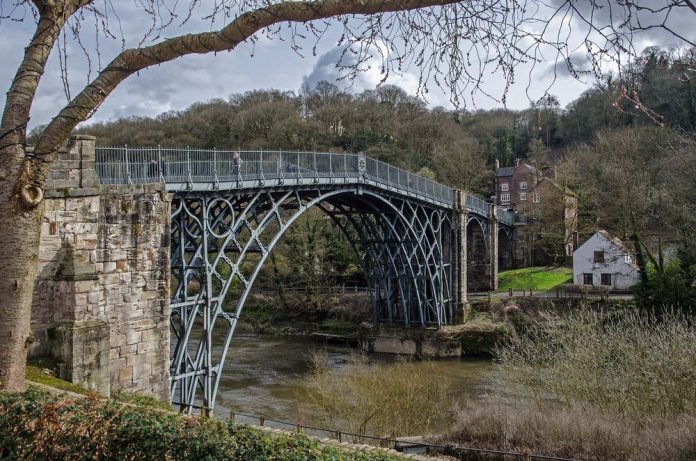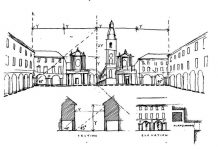The innovations and the development of engineering that gave an impetus to the Industrial Revolution also prepared the ground for revolutionary changes in the field of construction. The progress of mass melting technology in metal casting and the invention of the industrial steam machine by James Watt in 1763 played a special role.
The introduction of iron and steel in construction systems made it possible to overcome the existing limitations in covering large spans and to build taller buildings. The first breakthrough on the way to mastering the new engineering techniques took place in the 18th century. In 1779, the world’s first cast iron bridge was erected on the Severn River in Coalbrookdale, the United Kingdom (architect Thomas Pritchard).
This innovative structure used cast iron from the Coalbrookdale foundries nearby. It was a three-span arched bridge with a total length of 60 m and a median span 30.7 m, whose knots were made by using the carpentry jointing details typical for wooden construction techniques. The success of the bridge over the Severn River, which survived several floods, heralded a century of further development of cast iron and steel structures in Europe and America. An important milestone in this innovation relay was the first bridge suspended on steel ropes, which was raised across the Rhône River in Tournon, France in 1824.
In America another impressive structure came into existence – the Brooklyn Bridge connecting Brooklyn with Manhattan in New York (1870–1883), designed by John Augustus Roebling, a German-based construction engineer and architect. The Crystal Palace built for the Great Exhibition of the World 1851 in Hyde Park, London, the iron Garabit Viaduct from 1880–1884 over the Garabit Valley and the Truyère River near the village of Ruynes-en-Margeride in the Cantal department in France, designed by Gustavus Eiffel (a length of 565 m, spans of 165 m, and a height of 80 m), and the 300 m-high Eiffel Tower, erected for the World Exhibition in Paris in 1889 are further examples of early innovative architecture.
Of the above-mentioned innovative works, the British Crystal Palace was undoubtedly of the greatest importance for the further development of architecture. It is a phenomenon that marks the influence of industrialization on the shaping of form and public space with the help of new industrialized production methods and construction technology, which, in addition, initiated a different beauty.
The premonition of a new era of design was expressed at the opening of this unprecedented building of unparalleled scale (length 564 m, width 138 m, and nave height of 42 m), constructed of cast iron, wood, and glass. This is confirmed by the statement of German politician and writer Lothar Bucher: “The Crystal Palace is a revolution in architecture from which a new style will date”. It was designed by Joseph Paxton, who was an experienced greenhouse constructor.
His tender was selected for its distinctive lightness and relatively low cost. Its chief asset was the fact that its repetitive structure enabled the use of the prefabrication process, which enabled it to be quickly dismantled and reassembled elsewhere. Discarding the patterns of Victorian architecture, Joseph Paxton abjured elements of decoration. The three-exhibition building with the main nave of barrel glass supported on semi-circular laminated-wood girders and with galleries in the lateral aisles was a simple response to the specific function and short exposure time.
The only decorative elements of this transparent structure were the colours used: the interior was painted white, red, blue and yellow, whilst the outer colour was cyan. The construction of such a gigantic, completely glazed building was possible thanks the progress made in flat glass casting techniques in the UK at that time. The use of a modular construction system and glazed panels, based on the maximum dimension of a 1.2 m glass pane, allowed the structure to be built at the fast pace of 10 months.
The structure system was designed by using only four types of carrier beams of 7 m up to 22 m. The cast iron pillars, bolted on, were used simultaneously to drain rainwater. Industrially produced posts and beams were tested on the construction site for strength with hydraulic presses, and then set in place by cranes. Thanks to its lightness and transparency, the edifice seemed to be infinitely large, beyond past sensual experiences.
In its impressive enormous interior, natural trees and statues emphasized its splendour, manifesting the triumph of mankind over nature. The Crystal Palace, recognized at that time as a great success and architectural wonder, was a triumph of engineering, giving a special rank to the new event – a world exhibition. The Crystal Palace aroused the imagination of artists, architects, and writers in the first three decades of the 20th century and inspired further creative exploration.
The 1851 London Exposition, recognized as the first truly international exhibition, launched a period of world rivalry in all areas of invention and production. An example of such competition in technical and architectural innovation was the world exhibition in Paris, 1889, and the Eiffel Tower, which was especially erected for this exposition to demonstrate to the world not only the level of French engineering knowledge but also the technical possibilities of the epoch.
The construction of the Crystal Palace emphasizes an important moment of creation of a new type of large-space building complexes for short-term exposure, erected by methods of industrial prefabrication. These were the temporary structures of world exhibitions that distinctly revealed the features we identify with modernity, namely, variability, mobility, and lightness in a structure obtained in repetitive mass production, and values such as unity of function, structure system and space, open plan, and transparency.
The scientific and industrial revolutions in Europe were accompanied by similar transformations on the American continent. In the economic boom of the 1880s in America, the first ten-floor modern skyscraper appeared – the Home Insurance Building in Chicago (1883–1885), designed by William Le Baron Jenney. It was built with the iron skeleton system, complemented by the first steel beams to support the masonry shell of floors and walls, thus marking the beginning of a new era in the field of skeletal engineering structures, further developed by a group of architects who became part of the so-called “Chicago School” of skyscraper design.
William Le Baron Jenney is considered the creator of the “school”. He was in fact a brilliant engineer and architect who completed his comprehensive education at the École Polytechnique and the École Centrale des Arts et Manufactures (where he studied at the same time as Gustave Eiffel). In the favourable conditions of the American economy, he was able to use his knowledge, talents, and abilities to achieve spectacular success in both engineering and business. Jenney played a similar role to Peter Behrens in Germany around 1910 and August Perret in France.
Such eminent architects and engineers as Louis Sullivan, Daniel Burnham, William Holabird, and Martin Roche gained their expertise and achieved high status after professional training in Jenney’s office. Thanks to their initial collaboration with him, they became central figures of the Chicago School. These architects and engineers were the first to implement innovative technologies based on the iron and steel skeleton and created the prototype of the high-rise offices and commercial buildings in America.
The experimental use of lighter steel beams instead of iron ones, which took place for the first time in the headquarters of the Home Insurance Building in Chicago, inspired the search for a new way of shaping space. The innovative system, despite the higher costs, had enormous advantages. It had better fire protection parameters and thinner walls. The use of curtain walls in the structural skeleton freed the walls from the load-carrying function, which gave the possibility of larger glazing in the exterior façades and considerable freedom to shape a more open floor plan.
Making use of natural light was of great importance when electrification was just beginning. The dynamic development of new technologies using cast iron, steel, and glass became a challenge for architects. The favourable economic conditions in the late 19th century in the US gave rise to an unprecedented pace of building structures with new features (large office and commercial centers) on a gigantic scale. At the same time, with the current canons of architectural art, the modernization of the aesthetic expression of erected structures could not be done immediately.
The simplification of the structure at the beginning was nothing more than abandoning the monumental neoclassical forms and reducing the number of details and ornaments. A special bravery was needed to demonstrate a more abstract approach that would extract the pure beauty of the skeletal structural system. Such boldness, supported by the conviction that the synthetic treatment of the structure elements is a value in itself, has been gained by only a few. William Le Baron Jenney was one of them. A very pragmatic person, he prioritized the economics, simplicity, and understanding of construction.
His conviction, expressed in numerous publications, that we can speak of aesthetic values only when the established practical objectives were resolved in a satisfactory way would become one of the tenets of the doctrine of the next century’s modernist functionalism. His views were expressed in the design of buildings; for example, in the Leiter Building I in Chicago, 1879, in which he provided the modular system of vertical pillars and accentuated wide window openings on the façade while reducing the decoration to a minimum.
The strongly exposed rhythm of the structural skeleton became a new means of expression in architecture. This pattern, initiated by Jenney, was followed by other architects. The tendency to minimize ornaments and reduce forms to the rhythm of vertical ryzalits and the horizontal lines of sills was strongly expressed in the Marquette Building in Chicago 1894, designed by architects Holabird and Roche.
The process of further simplification bringing the aesthetic expression of the façade to the rectangular grid of divisions, which was initiated at the end of the 19th century, was continued later by Mies van der Rohe in the “Second Chicago School” after the invention (by Alastair Pilkington in 1952) of float glass. Concrete was another essential material, after iron, that set the stage for the modernist movement in architecture. The composite building material, formed by mixing binders (cement), filler (aggregate) and additives to give the desired characteristics, was already known and appreciated in ancient Assyria and Rome. However, it came back into use only in the 19th century when steel reinforcement was added to improve its properties.
The combination of concrete, which resists compression forces, with steel, which resists tensile stresses, produced a new material – reinforced concrete, which increased the possibility of building different types of long-span structures. Reinforced concrete was invented by French gardener Joseph Monier, who patented the reinforced flowerpot (1867) he produced by inserting a wire mesh into a mortar shell. The possibility of using this composite for construction purposes was demonstrated at Expo 1867 in Paris. It was also Monier who patented new building materials – a concrete slab (1869) and the reinforced ceiling beam (1878). He also designed and built a reinforced concrete bridge for Castle Chazelet (1878).
The importance of reinforced concrete for architecture is so significant because it makes it possible to erect structures of arbitrary, even sculptural shapes at a lower cost than with steel. It is no wonder that from the end of the 19th century to the present, it has played an extremely important role in construction. The self-educated French engineer François Hennebique launched the era of the mass use of concrete in construction in the late 19th century. He saw Monier’s reinforced flowerpot at the World Exhibition in Paris in 1867 and experimented with the use of concrete in a protective coating of cast iron at the construction site in Lombartzyde, Belgium (1879).
As a result of these experiments, he concluded that it would be simpler and cheaper to replace the skeleton of iron with iron bars inserted in the poured concrete. He invented a composite material by combining concrete and iron, which he described as “béton armé”, and patented it in Belgium in 1892.8 He devised an innovative construction system of reinforced concrete connecting such separated elements as the column and the beam to a monolithic element. Hennebique applied this new technology to a bridge he designed in Viggen, Switzerland (1894).
The patent, which resolved the problem of the connection between a column and a beam, heralded an era of the application of the reinforced concrete skeleton, initially referred to as Hennebique’s system in architecture. Hennebique’s large construction company thrived, completing 7000 projects between 1892–1902 and 2004. However, only in the projects of the famous French engineer Auguste Perret did the reinforced concrete skeleton take on the characteristics of a noble architectural medium.
The development of technology expanded the technical possibilities in architecture. The introduction of concrete, cast iron, steel, and glass constructions revolutionized building construction and architecture in that it was possible to build taller structures and overcome larger spans. However, this was not the most important thing. Development in architecture is not just about technical progress. As technical progress developed, the scale of perceiving problems evolved, expanding the potential of human imagination.
It was now possible to create designs on a new, previously unimaginable scale, going beyond the former limits. These new potentials raised admiration, surprise, and sometimes consternation, especially because the academic tradition of aesthetic values did not form an intelligible comparative base for these new aesthetic perceptions.
This is best expressed by the reflections on the Crystal Palace during the World Exhibition in 1851 in London. Lothar Bucher articulated this in a sentence, Therefore, in architecture not only do building techniques evolve but also concepts, spatial schemes, and ways of solving design problems. This phenomenon found a definite manifestation in the transformation that occurred in the architecture of the early 20th century.



















